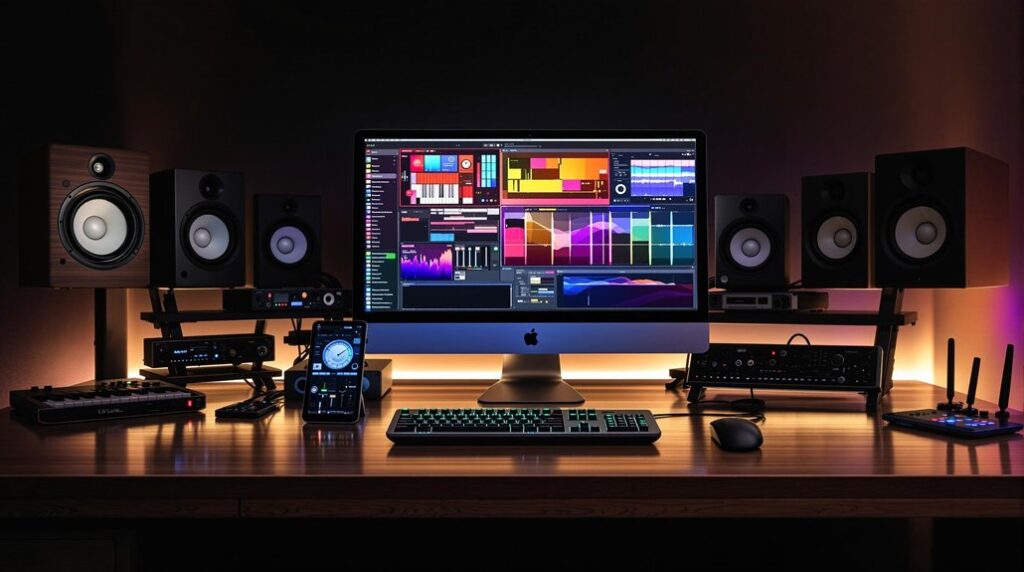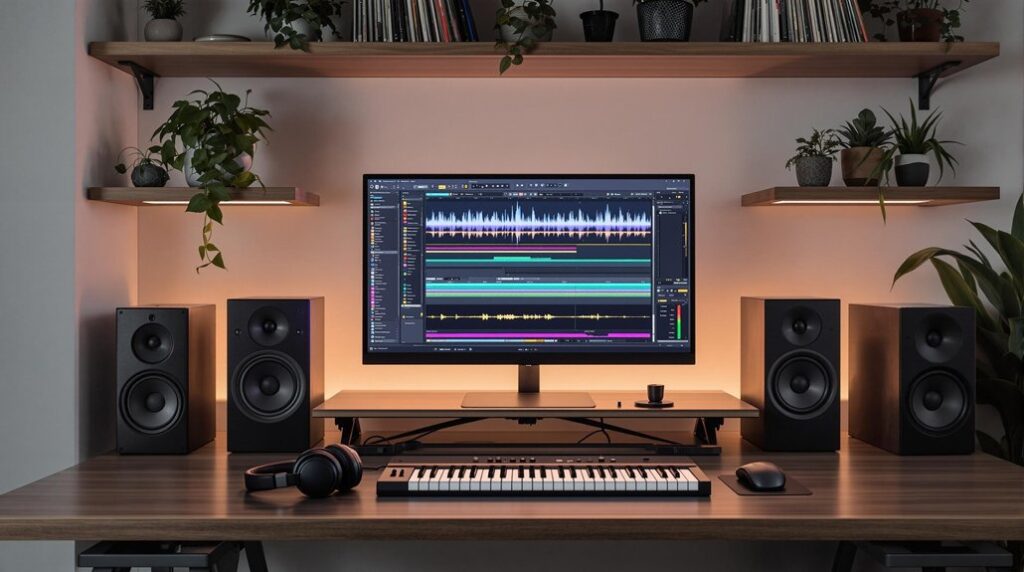To use Kontakt in Ableton, start by ensuring Kontakt is installed and set in your VST folder. Then, open Ableton, create a new MIDI track, and drag the Kontakt plugin onto it. Next, load an instrument from Kontakt’s library. Map your MIDI controller to control parameters easily, and apply effects via the Effects Rack for an enhanced sound. Set up multi-output routing to manage different instruments effectively. Finally, explore advanced techniques for unique sound design. There’s plenty more you can discover to boost your music production game.
Key Takeaways
- Ensure Kontakt is installed and correctly set up in Ableton by adding its VST folder in Preferences and rescanning plugins if necessary.
- Create a new MIDI track and drag the Kontakt plugin onto it to access the instrument browser.
- Browse and load desired instruments from Kontakt’s library, utilizing the built-in keyboard for sound previews.
- Set up MIDI control by linking parameters to your MIDI controller and saving custom mappings for future use.
- Define multi-output routing by assigning Kontakt’s output channels to separate audio tracks in Ableton for better control.
Setting Up Kontakt in Ableton
To get started with setting up Kontakt in Ableton, you’ll first need to confirm that Kontakt is properly installed on your system.
Make certain you’ve configured Native Access to place the VST files in a custom folder that Ableton recognizes.
Next, open Ableton Live and head to Preferences. Here, add your custom VST folder path to guarantee Kontakt appears in the browser.
Create a new MIDI track, then drag and drop the Kontakt plugin from the browser onto the track.
Don’t forget to enable both VST2 and VST3 plugin formats in Ableton’s preferences for ideal compatibility.
If Kontakt doesn’t show up, simply rescan the plugins in Ableton to resolve any visibility issues.
You’re now ready to use Kontakt!
Loading Instruments in Kontakt
To load instruments in Kontakt, start by opening the Kontakt instrument browser within your MIDI track.
You can easily explore a wide range of sounds by browsing through categories that fit your project. Just double-click an instrument to load it, and use the built-in keyboard to preview different sounds before you make your final choice!
Accessing Kontakt Instrument Browser
Accessing the Kontakt Instrument Browser in Ableton is a straightforward process that opens up a world of sound possibilities.
First, create a MIDI track and drag the Kontakt VST from your browser onto it, or simply double-click the Kontakt icon to load it directly. Once loaded, the Instrument Browser will appear within Kontakt, showcasing a vast library of instruments across categories like orchestral, electronic, and world sounds.
You can filter instruments by type, genre, and characteristics to quickly find what you need. To explore sounds, click on the instrument icons or use Kontakt’s built-in keyboard interface.
Double-clicking any desired sound loads the instrument into your project, ready for customization. Happy sound hunting!
Loading and Previewing Sounds
Loading sounds in Kontakt within Ableton is a seamless process that can enhance your music production.
Begin by opening a MIDI track and dragging the Kontakt plugin from the browser or double-clicking it to place it on the track. Once Kontakt is open, click the “Libraries” tab to access the instrument browser, where you’ll find a wide array of sounds organized by type and genre.
To load an instrument, double-click it or drag it into the Kontakt interface, which will show it in the Multi Rack. Use the built-in keyboard to preview sounds before fully loading them, helping you evaluate their tonal qualities.
Adjust parameters like filters and effects directly in Kontakt to customize the sound to fit your vision.
MIDI Control Mapping
Mapping MIDI controls in Kontakt is essential for real-time sound manipulation.
Start by right-clicking on any parameter you want to control and select “Learn MIDI CC Automation” to link it with your MIDI controller.
This way, you can customize your setup to fit your unique performance style and easily control multiple parameters at once.
Assigning MIDI Controls
When you want to take control of your sounds in Kontakt, assigning MIDI controls is an essential step that enhances your creativity.
Here’s how to do it:
- Enter Mapping Mode: Right-click on the parameter you want to control and select “Learn MIDI CC Automation.”
- Link Your Controller: Move the knob, slider, or pad on your MIDI controller to link it to your selected Kontakt output parameter.
- Save Your Mappings: Don’t forget to save your custom MIDI mappings as presets in Kontakt for easy access in future projects.
Before starting, make sure your MIDI controller is properly set up in Ableton’s Preferences under the MIDI/Sync tab.
Group related parameters for a more intuitive control experience!
Real-time Sound Manipulation
To achieve real-time sound manipulation in Kontakt while using Ableton, you’ll want to start by assigning your MIDI controller to specific parameters.
Right-click any parameter in Kontakt and select “Learn MIDI CC Automation.” Make sure your MIDI controller is connected and recognized by Ableton. This allows you to map knobs, sliders, or pads to Kontakt parameters for immediate access during your performance.
You can adjust multiple parameters, like filter cutoff and resonance, simultaneously for more expressive sound design. Don’t forget to save your customized MIDI mappings as presets within Kontakt, making it easy to recall them in future projects.
Experimenting with different assignments can reveal unique sound manipulation techniques, enhancing your musical performances as a VST plugin user.
Applying Effects and Modulation
Applying effects and modulation in Kontakt can greatly enhance your sound design, making your tracks more dynamic and engaging. Here’s how you can get started:
- Utilize the Effects Rack: Apply reverb, delay, and distortion to shape your sound and add rich textures. Proper use of reverb types can significantly influence the overall character of your mix.
- Map Parameters: Connect effect parameters to Ableton’s macro controls for quick, on-the-fly adjustments during performances or mixing.
- Experiment with Modulation: Use LFOs and envelopes to add movement and depth, dynamically shaping your sounds.
Advanced Techniques and Scripting
Building on the effects and modulation you’ve already explored, advanced techniques in Kontakt open up a world of creative possibilities.
Start by diving into the Kontakt Script Processor (KSP) to create custom scripts that enhance your instruments. Implement dynamic parameter control in your scripts for expressive performance interactions. Experiment with real-time script processing to manipulate sounds on-the-fly, making your music production more engaging.
Next, create complex MIDI mappings that let you control multiple parameters with a single MIDI controller, streamlining your setup.
Don’t forget to save your custom scripts as presets within Kontakt for quick access in future projects. By mastering these advanced techniques, you’ll uplift your performance and production to a new level. Additionally, consider exploring sound design resources to further expand your creative toolkit.
Multi-Output Routing
Multi-output routing in Kontakt is a game-changer for your music production setup, allowing you to manage multiple sounds with ease.
Here’s how to set it up:
- Navigate to the output section in Kontakt and define the number of output channels you need.
- Create multiple audio tracks in Ableton and assign each track to the corresponding Kontakt output (e.g., Output 1, Output 2, etc.).
- Reserve the main output for the Kontakt track, using auxiliary outputs for the additional audio tracks.
Don’t forget to assign each instrument to its respective MIDI channel for better control during playback and mixing. Additionally, implementing surgical EQ cuts can enhance the clarity of each sound as you mix.
Finally, save your output configurations as presets in Kontakt for quick setup in future sessions.
Enjoy working with Native Instruments!
Additional Resources and Support
While diving into the world of Kontakt within Ableton, you’ll find various resources and support options to enhance your experience.
Start with video tutorials on platforms like YouTube; they provide step-by-step guidance on using Native Instruments. The Native Instruments community forums are perfect for troubleshooting issues and sharing insights with fellow users.
Don’t overlook the official documentation and user manuals for both Kontakt and Ableton, which detail features and best practices. Additionally, explore online articles dedicated to music production for tips on maximizing Kontakt’s effects in your workflow.
Finally, consider attending webinars hosted by experts—their knowledge can offer innovative techniques to boost your music production game. These resources will also help you understand advanced sound design techniques to create unique productions.
Frequently Asked Questions
How Do I Use Kontakt Player in Ableton?
To use Kontakt Player in Ableton, explore its features by dragging it onto a MIDI track. Utilize Ableton shortcuts for efficiency, and assign controls with MIDI Learn for enhanced performance and seamless sound manipulation.
How to Connect Native to Ableton?
To connect Native Instruments software like Kontakt for seamless integration, guarantee your Ableton setup includes the correct VST paths. Install Native Access, configure settings, and rescan plugins to access Kontakt in your projects effortlessly.
How Do I Use Kontakt Files?
To use Kontakt files, browse the Kontakt library for instrument presets, set up audio routing, and apply MIDI mapping. You’ll quickly access diverse sounds and customize them to enhance your music production.
How Do I Load an Instrument Into Ableton?
To load an instrument into Ableton, start by accessing your instrument libraries. Drag and drop your desired instrument onto a MIDI track, then you can play, adjust settings, and record your sounds easily.
Conclusion
Now that you’ve learned how to set up Kontakt in Ableton and explore its features, you’re ready to raise your music production. By loading instruments, mapping MIDI controls, and applying effects, you can create rich, textured sounds. Don’t forget to experiment with multi-output routing for a more dynamic mix. Keep practicing these techniques, and soon you’ll be crafting tracks that truly showcase your creativity. Immerse yourself and enjoy the process—your musical journey is just beginning!




